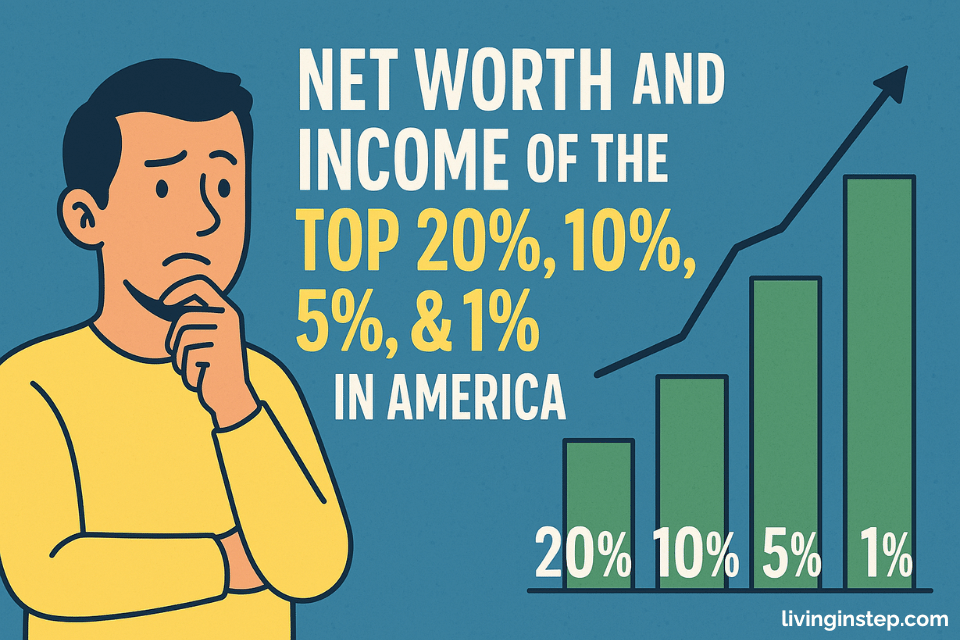We hear about “the top 1%” all the time
Usually with either awe or criticism
But what does that actually mean?
What kind of net worth gets you in?
How much do they earn?
And what about the top 20% or 10%—is that even attainable?
Turns out the data paints a clear picture
And it’s more interesting than you might think
Let’s walk through the actual numbers
And see where things really stand
Let’s start with the top 20%
This one might surprise you
Because it’s not as out of reach as it sounds
To be in the top 20% of U.S. households:
- Median net worth: $558,189
- Annual household income: $130,000+
Yes, it’s higher than average
But it’s not millionaire territory
It’s just consistent earners who spend less than they make
(Important side note: over half of people earning $100K+ save nothing—so income isn’t everything.)
Climbing into the top 10%
This is where things start to look different
More security
More breathing room
But still far from ultra-wealthy
To make it into the top 10%:
- Median net worth: $1.9 million
- Annual household income: $248,600+
That’s not monthly income
That’s yearly household income
So if you’re thinking “I’ll never make that,” remember—it’s not about hitting it all at once
It’s about stacking consistent progress over time
Also: there are 15 million millionaire households in the U.S.
That number’s growing
Not because of lottery wins
But because of long-term habits that eventually snowball
Many here are business owners, experienced professionals, or long-term investors
The interesting part?
A lot of them got here just by being consistent
Not dramatic
Not lucky
Just persistent
The top 5%: Things escalate quickly
Here’s where the shift becomes seriously noticeable
To be in the top 5%:
- Median net worth: $3.8 million
- Annual household income: $350,000+
That’s a huge leap
But again—it’s not all income
Much of this is built through time in the market, asset appreciation, and living below their means
These households usually have diversified investments
Paid-off or high-equity homes
And often multiple income streams
The people in this group tend to be disciplined
But not necessarily flashy
You’ve probably walked past one at the grocery store and never known it
The top 1%: Now we’re in a different category
This is the group people talk about with headlines
But let’s strip away the narrative and look at the numbers
To be in the top 1%:
- Median net worth: $13.7 million
- Annual household income: $650,000+
This is the group that gets the headlines
But most of them aren’t making their money through salaries
But most people in this group aren’t earning all that through salaries
A lot of it comes from investments, capital gains, and ownership
The point isn’t to idolize or demonize
It’s just to understand where the financial power sits
The top 0.1%: Just for perspective
If the 1% feels intense, this one is staggering
To be in the top 0.1%:
- Net worth: $46.3 million
- Annual household income: $3.21 million+
At this level, it’s not about income from work
It’s capital
Ownership
Equity
And exponential scale
For context:
At $3.2 million per year
That’s roughly $1,500 per hour—assuming a 40-hour week
(But let’s be honest—most aren’t working for wages anymore)
This level represents generational wealth
Institutional connections
And assets that often grow faster than they can be spent
So where does that leave everyone else?
That’s the question most people reading this are probably asking
Because the point of these numbers isn’t to shame or show off
It’s to give Perspective
You might be closer to the top 20% than you think
Or you might just now be building your base
But either way—these numbers aren’t designed to make you feel behind
They’re here to help you set your own benchmarks
Not based on social media
Not based on marketing
But based on actual data
The game isn’t to “be in the 1%”
The game is to create freedom for yourself
And understanding the ladder helps you do that—on your terms
And maybe most importantly—
They remind you that most financial success stories aren’t loud
They’re built over time
In silence
And with way fewer flexes than you’d think
Sources:
- Federal Reserve Board – Survey of Consumer Finances (2022)
- U.S. Census Bureau – Income and Poverty in the United States (2023)
- Kiplinger – What It Takes to Be in the Top 1%, 5%, 10%, and 20%
- Moneywise – Net Worth Thresholds by Wealth Percentile (2024)
- Investopedia – Net Worth of the Top 1% in America
- Financial Samurai – Top 1% Net Worth Amounts by Age
- Unbiased – Top 0.1% Income Threshold (2025)
- LinkedIn (Liz Ann Sonders) – Net Worth of Top 0.1% (2024)
Note: This content is for entertainment purposes only and is not financial advice. Please consult a qualified financial advisor for guidance specific to your situation.








